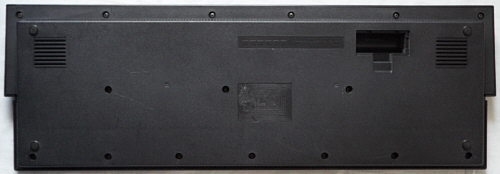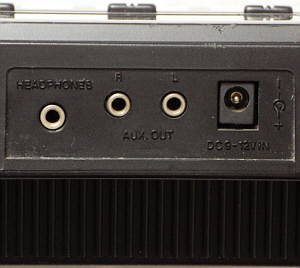
|

This is another oddity in the bizarre world of "MC" keyboards. Although this 49 midsize keys tablehooter looks very much like a real 1990th sound bank instrument and even selects all functions by typing 2 ciphers and "enter", it is rather a toy than a serious keyboard because its main voice has only 1 or 2 note polyphony and 8 different sounds (squarewave, resembling Letron MC-3). But in spite of this it features key split presets, programmable drum pattern and a variety of 32 trashy rhythms made from 3 dull low-res percussion samples with street-organ-like tooting polyphonic squarewave accompaniment; these archaic warm sounding alternating bass and chord tones make it sound special. A highlight of this thing is the included song bank with 32(!) different demo melodies arranged in a simple Commodore C64 home computer style, which makes it an interesting find for a squarewave lover.
(Note: This keyboard sounds nice, but don't buy one of these so far your only intention is to get a keyboard with faithfully imitated natural instrument sounds. Remember, this is a squarewave instrument and though many of its sounds sound not even remotely like what is written on its buttons, though bought with wrong expectation it may disappoint you.)
 (old eBay photo of my specimen)
(old eBay photo of my specimen) |
 |
 |
- cymbal sound in percussion IC (may be rewired to another percussions).
The 'violin, 'clarinet', 'cowbell' and 'oboe' sound contain square 6Hz vibrato. The 'mandolin' rings at about 8Hz. The 'clarinet' is harsher than 'oboe' (possibly the manufacturer confused both). The 'cowbell' is rather a high pitched vibraphone with long decay envelope and resembles the famous 'fantasy' sound of a Casio VL-Tone 1. By unknown reasons the 'mandolin', 'xylophone' and 'cowbell' are only monophonic, which is quite annoying, but even with 2 note polyphonic sounds often 1 note mutes the other during fast play when there are too short or missing pauses between key presses. With monophonic sounds when you hold 1 key and trill another, the 1st key sounds again once the 2nd is released, which can be used to play 2 note trills. With the key split presets there is always one of the above sounds assigned to the accompaniment section and another to the melody section of the keyboard. Both sections here are always monophonic and can be played together (without flaws during fast play).
The monophonic rhythms are made from 3 low-res percussion samples with audible start and end click, which gives them a fat and bassy, trashy timbre and is well suited to synchronize brain waves for meditative musics. Apparently the samples are muffled by a capacitor.
The single finger accompaniment alternatingly plays envelopeless plain squarewave organ bass and duophonic sort-of chord notes (i.e. no real 3 or 4 note polyphonic chords). The accompaniment recognizes only 3 standard chords and with accompaniment only monophonic main voice play is possible, but at least it recognizes chord changes reasonable fast. The accompaniments have a cute and cheesy orchestrion or fairground organ appeal and the 32 available styles also include many unusual patterns beyond waltz and tango.
With the "custom drummer" a user rhythm pattern can be programmed step
by step to any of the given accompaniments. This can even be done while
the rhythm is playing, but every button press always makes a blip noise,
which limits its use as a realtime drum computer. Strange is that the button
press blip uses an own squarewave tone channel that works independently
from the very limited polyphony of the rest. Strange is also that the drumpads
show instead of {base, clave, snare} icons for {base, snare, cymbal}; possibly
initially a different rhythm IC or wiring was planned.
circuit bending detailsThe Elite MC-2200 is based on the single-chip CPU "SC-MC-22", which outputs 2 squarewave sound channels and trigger pulses for envelope and 3 percussion samples of the percussion IC "82100". Additionally it outputs plain squarewave accompaniment through 3 pins.
envelope controlThe analogue envelope control in SC-MC-22 is more intelligently programmed than in MC-2 and so uses the length pins (18, 19) also to change the note length of decaying sounds according to the key press duration. The length pin of an unused 2nd channel stays always lo. In all preset sounds except 'cowbell' during decay the tone is shut off after 0.5s (which is sufficient for the employed capacitors). Preset sounds those play an octave higher are only monophonic; possibly the CPU was considered too slow to render them properly on 2 channels. However the split sounds can combine 2 of them, which makes this less likely (unless the keyboard scanning gets faster when each halve is monophonic).
The envelope behaviour of the "SC-MC-21" CPU is fully identical, except that its hi octave preset sounds are not monophonic. rhythm & accompanimentDespite there are enough CPU pins and the percussion IC "82100"contains 4 samples, in MC-2200 the 'cymbal' is neither used nor connected. I suspect that (like in Casio VL-1) the limit of 3 percussion sounds was done to save rom space by encoding rhythm patterns in 2 bits per beat (3 percussion + pause) to make space for more demos, because this tablehooter was made upon a time where Casio and Yamaha already had 100 preset sounds, plenty of PCM rhythms and songbanks with dozens of demos, with those the Chinese wanted to compete despite ridiculously inferior hardware. So they decided to build a keyboard controlled by the so modern hyped cipher buttons (including that annoying button click), many accompaniments and demos, while completely ignoring polyphony or variety of sounds.Because each percussion is triggered by a single CPU pin to the percussion IC "82100", you may rewire them (including the 'cymbal') through switches to make more rhythm variations. The sample pitch is controlled by the 150k resistor R20 between percussion IC pin 2 and 3. Also the 3 accompaniment outputs certainly can be rewired for more variations of the cute squarewave accompaniment. disable button clickThe button press blip sound comes from an own sound channel at CPU pin 17. You may disconnect this nuisance if you don't like it.keyboard matrixThe keyboard matrix has no eastereggs, but here is it for comparison. Like SC-MC-2, the keyboard matrix inputs need unusually low resistance (below 1k) to respond. Places 28->35 and 29->35 do nothing (no button click) but block the panel buttons, so there are no eastereggs.
The input lines are active-low, i.e. react on GND. Any functions can
be triggered by a non- locking switch in series to a diode from one "in"
to one "out" pin.
pinout 82100The "82100" (9 pin COB, by Medeli?) is the percussion IC of Elite MC-2200 and some other 1990th toy grade music keyboards. It is monophonic and contains 4 low resolution percussion samples {base, snare, clave, open cymbal}, those are output when the corresponding pin is pulled low. Holding the pin longer repeats the sample in a loop. Pitch is controlled by an external clock resistor (at clock frequency, no DC control). The clock frequency with 150k is about 147kHz.
pinout SC-MC-22 & SC-MC-21The "SC-MC-22" (42 pin DIL) by Medeli is the CPU of Elite MC2200. It has internal ROM and outputs 2 squarewave sound channels and trigger pulses for capacitor envelopes and for 3 percussion. This CPU is a close successor of the SC-MC-2; it additionally outputs envelopeless squarewave accompaniment through 3 pins in an odd way. The vibrato is now part of the melody waveform (no external pin), which uses for each of the 2 channels an own envelope length pins (in a less stupid way than MC-2). There is also a blip sound output for the button click.The "SC-MC-21" is a software variation of the SC-MC-22 that was optimized for shorter keyboards like Bontempi ES 3000. It has fewer rhythms and only one demo (so it has only 4 cipher buttons), and to make better use of fewer keys, the custom drummer was replaced with a chord sequencer and the key split preset sounds were omitted. It supports the 4th percussion sound ('cymbal', only by drumpad, rhythms don't use it) - possibly because the removed custom drummer dropped the constraint of storing drumpad events in 2 bits per beat. But the existing preset sounds and rhythms are identical, except that here also hi octave preset sounds are not monophonic. It may be that the absence of 7 highest notes on the shorter keyboard lowered the requirements or that the omitted keyboard matrix out pin 35 has freed enough computing time to support the 2nd polyphony channel. Even the "Brother John" demo song plays (beside a tiny speed variation) on both chips identical, which shows how similar SC-MC-22 and 21 actually are. This CPU is likely the same OKI microcontroller like MC-3DX (which uses an external sound IC) of the famous MC-3 keyboards with changed software to produce tones by itself. This pinout is based on my own analysis of Elite MC2200 and Bontempi
ES 3000. I combined both pinouts because only 3 pins differ. The pin names
were taken from the "SC-MC-3"
pinout in book "Keyboard Principles" (typos fixed by OKI MSM6404VS
datasheet) and line names chosen by me to describe their functions (partly
inspired by Casio naming conventions).
Pin 25 seems to be an unused output (fairly low resistance) that stays always lo. The unused pin 4 in SC-MC-22 outputs a trigger pulse when any other percussion pin (5..7) does the same, so it was likely intended as a handshake for a more complex percussion generator that uses pin 5..7 to address more than 3 sounds. In SC-MC-21 this is the trigger out for the cymbal drumpad. Also the chord led pin 36 and key matrix out pin 35 are not used (lo) in SC-MC-21. The accompaniment pins 23 and 24 behave odd. Pin 23 is mixed with pin 22 (bass out) through resistors. I first thought there were hidden additional polyphony channels in their signal because the resulting waveforms behind resistors are strange (and with changing notes jump up and down into 4 positions by DC offsets), but at the pins itself it is only plain squarewave. Apparently all tone generators simply stay at their level (hi or lo) after stopping instead of returning to a default level, which makes their DC offset jump around and so may produce interesting transients colouring the timbre. (Some serial capacitors keep the DC out of the power amp.) |
The instrument has a library of 32 demo melodies in minimalistic but nice C64 squarewave sound:
The Elite MC2200 was also released as "Pan Toys MC-2200",
"Karcher F4" and "Tristar MC2200". Regarding the CPU type
label, also a variant named "MC-22" may exist, which appears to be the
genuine name of this hardware class. A technically very similar instrument
is the mini keyboard Bontempi ES 3000.
| removal of these screws voids warranty... | ||
 |
||
|
|